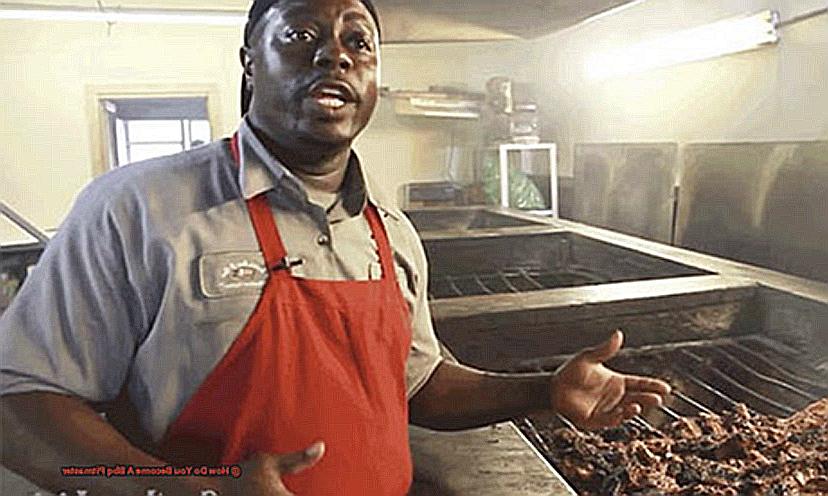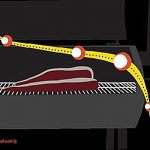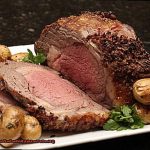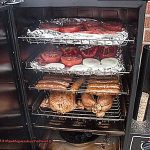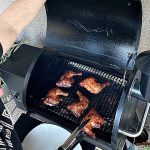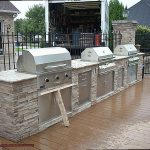Do you have a passion for grilling and smoking meat to perfection? Are you dreaming of becoming a BBQ Pitmaster? Well, hold on to your tongs because we’re about to take you on a journey towards mastering the art of BBQ. Cooking amazing BBQ is more than just a weekend hobby; it’s an art form that requires dedication, practice, and patience.
So, what exactly is a Pitmaster? A Pitmaster is an expert at grilling and smoking meat who has a deep understanding of meat cuts, seasoning, cooking techniques, and temperature control. To become one yourself, start with the basics and work your way up. This means investing in the right equipment like a good smoker, thermometers, and wood or charcoal.
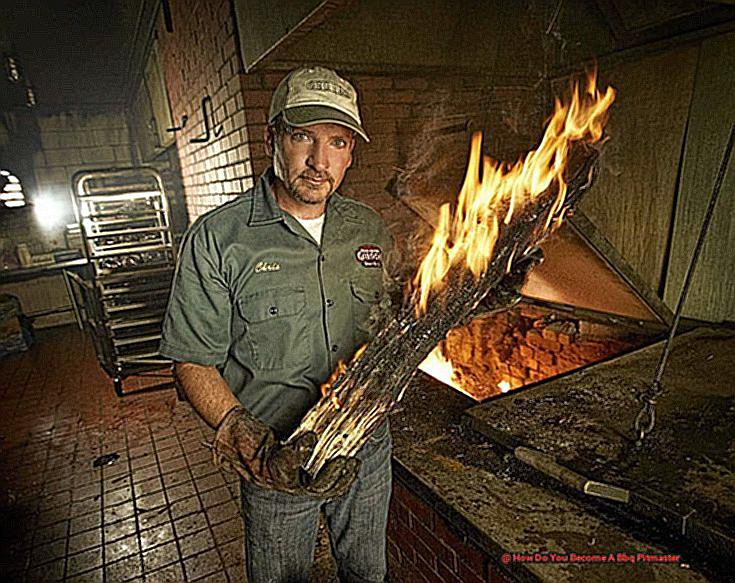
- Next up: essential skills. Building a fire, controlling temperature, cooking times, and flavoring techniques are all vital skills to master if you want to become a Pitmaster. But don’t worry if these seem daunting at first – with time and practice, you’ll get there.
- Lastly: learning from the best. Attend masterclasses, visit BBQ competitions, and seek out mentors who can teach you from their experience. With hard work and persistence (and maybe some tasty trial-and-error), you too can become a BBQ Pitmaster.
So let’s fire up that grill (or smoker) and get started on your journey towards becoming an expert in all things BBQ.
Contents
Understanding the Basics of Grilling
Grilling is not just a cooking method, it’s an art. It requires precision, patience, and an understanding of the basics. To become a BBQ Pitmaster, you must first grasp the fundamentals of grilling. In this article, we will explore the different types of grills, how to light them properly, how to control the temperature, and the various techniques used by BBQ Pitmasters.
Types of Grills:
There are several types of grills available in the market, each with its own unique advantages and disadvantages. The four main types of grills are:
- Gas Grill: These grills use propane or natural gas as a fuel source. They are easy to use and require minimal cleanup.
- Charcoal Grill: These grills use charcoal as a fuel source. They provide a smoky flavor that is difficult to replicate with gas grills.
- Pellet Grill: These grills use wood pellets as a fuel source. They offer the convenience of a gas grill with the flavor of a charcoal grill.
- Electric Grill: These grills use electricity as a fuel source. They are easy to use and require minimal cleanup.
How to Light a Grill Properly:
Lighting a grill is not as simple as it seems. The key is to use the right amount of fuel and give it enough time to heat up. Here’s how:
For a charcoal grill, pile the charcoal into a mound in the center of the grill. Pour lighter fluid over the charcoal and wait for it to soak in for a few minutes before lighting it with a long match or lighter.
For a gas grill, turn on one of the burners and let it heat up for 10-15 minutes before turning on the other burners.
For a pellet grill or an electric grill, simply turn it on and set the temperature.
Controlling the Temperature:
Temperature control is crucial to grilling. Different types of food require different temperatures, so it’s important to learn how to adjust the heat on your grill accordingly. Here’s how:
For a charcoal grill, adjust the vents to control the airflow and temperature.
For a gas grill, adjust the burners to control the temperature.
For a pellet grill or an electric grill, simply adjust the temperature setting.
Attending BBQ Classes and Workshops
It’s time to elevate your grilling game by attending BBQ classes and workshops. These sessions offer hands-on experience, expert instruction, and specialized content that will turn you into a bona fide Pitmaster.
One of the most significant benefits of attending BBQ classes and workshops is the structured learning environment they provide. Unlike trying to learn on your own, these sessions allow you to ask questions, receive feedback, and learn from your mistakes in a supportive setting. You’ll be surrounded by like-minded individuals who share your passion for BBQ and eager to help you improve.
Expert instruction is another major advantage of attending BBQ classes and workshops. Many of these sessions are taught by experienced pitmasters who have won competitions and earned championships. These experts will share their techniques, tips, tricks, and secrets with you, helping you take your grilling game to the next level. You’ll learn new ways to cook meats, select cuts, create marinades and rubs, and much more.
If you’re looking to specialize in a particular type of BBQ, attending a workshop that focuses on smoking, grilling or meat selection is an excellent option. These specialized sessions allow you to hone your skills in a specific area of BBQ. You’ll get practical experience working with different types of meats and learn how to handle them correctly.
Attending BBQ classes and workshops is also an opportunity for networking. You’ll meet other enthusiasts in the field, connect with other Pitmasters who share your passion for BBQ, and even make some lifelong friends along the way.
When selecting a BBQ class or workshop, it’s crucial to consider the instructor’s qualifications, class size, and cost. Look for classes taught by experienced professionals with proven track records. Make sure the class size is small enough to allow for individual attention and that the cost fits within your budget.
Reading Books and Watching Videos
Then look no further than the world of books and videos. These resources are packed with step-by-step guidance on how to master the art of BBQ pit smoking, providing valuable insights into the techniques, methods, and equipment required to cook delicious and succulent BBQ.
Let’s start with books. A good BBQ pit smoking book offers a comprehensive approach to learning about the art of BBQ, including history, technique, recipes, and more. Some of the most sought-after books on the subject are “Franklin Barbecue: A Meat-Smoking Manifesto” by Aaron Franklin, “Smoke and Spice: Cooking with Smoke, the Real Way to Barbecue” by Cheryl and Bill Jamison, and “The Barbecue Bible” by Steven Raichlen. Each of these books is a treasure trove of information that will help you take your BBQ skills to new heights.
But if you’re looking for a more visual approach, then videos are a great option. There are countless online sources where you can access instructional videos on BBQ pit smoking. These videos offer an up-close and personal look at the techniques used by expert pitmasters and provide valuable tips and tricks to help improve your skills. Some of the most popular online sources for BBQ pit smoking videos include YouTube, Vimeo, and Grilling.com.
Of course, while reading books and watching videos can be incredibly helpful in becoming a BBQ Pitmaster, it is important to remember that nothing beats hands-on experience. Practice makes perfect, so get out there and start cooking. Attend BBQ classes and workshops where you can hone your skills even further.
Investing in the Right Tools
If you’re serious about becoming a BBQ Pitmaster, then investing in the right tools is a must. Without the proper equipment, it’s impossible to create the mouth-watering dishes that will impress your guests. But where do you start? Let’s take a closer look at some of the essential tools every Pitmaster needs.
First and foremost, a smoker is the foundation of any successful BBQ dish. With so many types of smokers available, it’s crucial to do your research and choose one that fits your needs and budget. Whether you prefer charcoal, wood, or electric smokers, each has its unique features and advantages.
Next on the list is a thermometer. A thermometer helps you monitor the temperature inside your smoker and ensures that your meat is cooked to perfection. Digital thermometers are more accurate and easier to read, while analog thermometers are cheaper and more straightforward.
A good set of tongs, spatulas, and meat claws are also essential tools for any Pitmaster. These tools help you handle your meat safely and efficiently without piercing it. Tongs allow you to flip and move your meat with ease, while a spatula helps you move larger pieces like ribs or brisket. Meat claws are used to shred meat, making it easier to serve.
Investing in high-quality wood chips is another crucial element when it comes to BBQ. The type of wood chips you use can significantly impact the flavor of your meat. Experiment with different types of wood chips to find the perfect flavor for your BBQ dishes. Hickory chips provide a smoky and slightly sweet flavor, while mesquite chips offer a strong and earthy taste.
Lastly, don’t forget about a good BBQ sauce brush. A sauce brush allows you to apply BBQ sauce evenly on your meat without making a mess. Look for a brush with long and stiff bristles that can handle thick sauces.
Practicing with Small Cuts of Meat
To begin, it’s important to learn how to properly prepare the meat. This involves trimming off any excess fat or gristle and seasoning it with a delicious rub or marinade. You can find numerous recipes online or even create your own signature rub by experimenting with various ingredients.
Next, fire up the grill and preheat it to the desired temperature. Carefully place the prepared meat on the grates and keep a close eye on it as it cooks. This will help prevent any overcooking or burning, ensuring that your meat is cooked to perfection.
As you practice with small cuts of meat, you’ll start to develop a better understanding of how different cooking methods affect the flavor and texture of the meat. For instance, smoking adds a rich smoky flavor while high heat grilling creates a mouthwatering charred crust. So, don’t be afraid to experiment with different techniques and flavors. Try using various wood chips for smoking or adding a variety of spices to your rubs and marinades.
Moreover, practicing with small cuts of meat will help you perfect your grilling techniques and enhance your flavor profiles. Here are some sub-topics to consider:
- Experimenting with different cuts of meat like chicken wings, pork chops, or beef skewers.
- Learning how to control the grill temperature and cooking time for each cut.
- Trying out different marinades and rubs to find your favorite flavor combinations.
- Using different cooking methods like smoking, grilling, or indirect heat.
Experimenting with Different Seasonings and Techniques
As a BBQ Pitmaster, the possibilities for experimenting with different seasonings and techniques are endless, and they can make all the difference in creating mouthwatering, delicious barbecue. In this guide, we will explore the art of barbecuing by uncovering some tips and tricks to help you become a master at seasoning and cooking techniques.
Seasoning is a crucial factor that can make or break your barbecue. Dry rubs and marinades are two popular ways to add flavor to your meats before cooking. A dry rub typically consists of a blend of spices, herbs, salt, and sometimes sugar. The key is finding the right balance of flavors that complement your meat without overpowering it. Experiment with different ratios until you find your perfect blend.
Marinades are another great way to add flavor while also tenderizing meats. However, it’s important to remember not to leave the meat in the marinade for too long as the acid can start to break down the texture. Aim for 30 minutes to an hour for most meats, but always follow specific recipes for guidance.
Cooking techniques also play a crucial role in achieving optimal results. Smoking is ideal for tougher cuts of meat like brisket or pork shoulder because it allows them to cook low and slow, resulting in tender and flavorful meat. On the other hand, grilling is best for leaner cuts of meat like chicken breasts or steaks that cook quickly at high heat. Indirect heat is a great technique for achieving even cooking throughout the meat without overcooking or drying it out.
Keeping Track of What Works and What Doesn’t
Then it’s time to start keeping track of what works and what doesn’t work when it comes to your techniques. Here are some tips on how to do just that.
First and foremost, document every grilling session. Jot down the date, type of meat, temperature, and any other important details. This will help you easily refer back to your successes and failures and learn from them.
Photos are another powerful tool for tracking progress. Not only will they let you visually see how far you’ve come, but sharing them with others can lead to feedback and suggestions on how to improve. Plus, who doesn’t love drooling over mouth-watering BBQ pics?
Don’t forget the importance of feedback from those who have tasted your food. It can be tough to hear constructive criticism, but it’s the best way to learn from mistakes and keep improving.
And don’t be afraid to experiment. Trying new techniques and flavors is how you’ll develop your own unique style as a BBQ Pitmaster. Keep an open mind and be willing to take risks – that’s where growth happens.
Refining Your Skills to Develop Your Own Unique Style
It’s all about refining your skills, staying informed, seeking feedback, and focusing on the overall experience. Here are some actionable tips to help you stand out from the crowd.
Practice Makes Perfect:
To create a signature style, you need to experiment with different techniques, cuts of meat, and seasoning blends. Don’t hesitate to try new things and make mistakes along the way. With each session, document your progress through photos and notes to identify areas for improvement.
Stay Informed:
Keep up with industry trends and innovations by attending BBQ competitions, watching online tutorials, and reading books on the subject. This will not only broaden your BBQ knowledge but also inspire you to try new things.
Get Feedback:
Don’t be afraid to ask other Pitmasters or experienced BBQ enthusiasts for their feedback. They can offer valuable insights into what you’re doing right and what you could do better. Take their advice on board and use it to refine your skills.
Focus On The Experience:
Remember that becoming a BBQ Pitmaster is not just about the food; it’s also about creating a memorable experience. Pay attention to the ambiance of your cookout, the presentation of your dishes, and the interaction with your guests. All these elements contribute to creating an unforgettable BBQ experience that people will want to come back for time and time again.
Conclusion
To truly become a BBQ Pitmaster, you need to have a passion for the art of smoking meat. It’s not just about cooking food; it’s about mastering the craft and creating unforgettable experiences for your guests.
Start by investing in the right equipment. A good smoker, thermometers, and high-quality wood or charcoal are essential tools that can make all the difference in achieving that perfect flavor and texture.
But equipment alone won’t make you a Pitmaster. You also need to develop essential skills like building and maintaining a fire, controlling temperature, cooking times, and seasoning techniques. Seek out mentors who have experience in the field or attend masterclasses to learn from the best.
Books and videos can be helpful resources too but nothing beats hands-on experience. Experiment with small cuts of meat to try out different techniques and flavors without breaking the bank or wasting too much time.
Remember that becoming a Pitmaster is not just about mastering the technical aspects of smoking meat; it’s also about creating an experience for your guests. From presentation to ambiance, every detail matters when it comes to making your BBQ stand out.
Stay informed about industry trends and innovations while seeking feedback from other Pitmasters or experienced BBQ enthusiasts. This will help you refine your skills and develop your own unique style that sets you apart from others.
In conclusion, becoming a BBQ Pitmaster takes time, dedication, practice, and patience. But with the right mindset, tools, skills, and knowledge – anyone can become an expert in all things BBQ.

